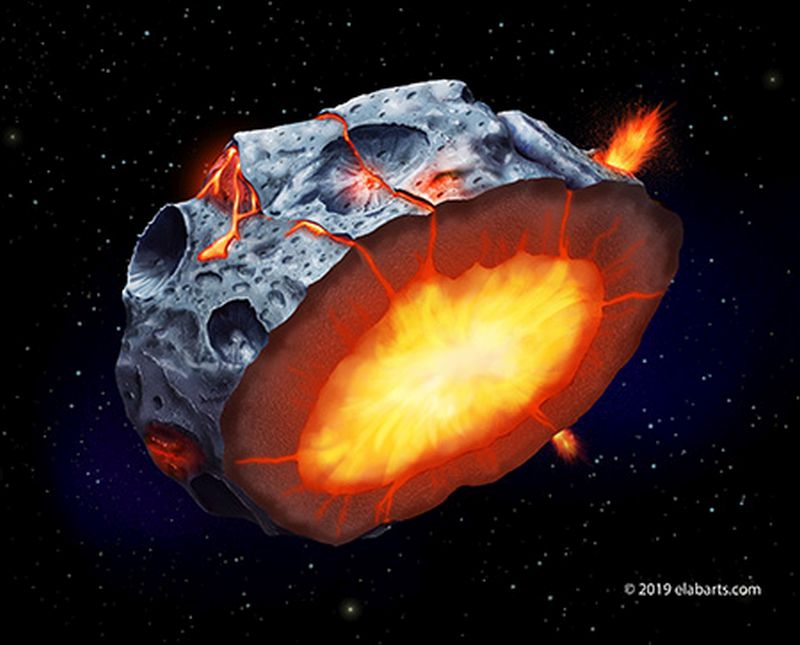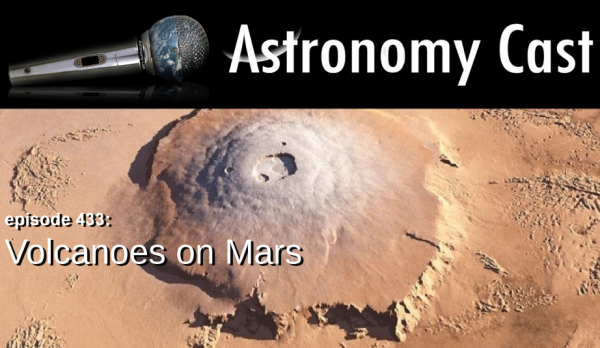Imagine a time in the Solar System’s past, when the asteroids were not solid rock, but blobs of molten iron. It sounds strange, but that may have been the case. And in the right conditions, some of those asteroids would have sprouted volcanoes. One of those asteroids, Psyche, is the destination for a NASA mission.
Continue reading “Metal Asteroid Psyche Might Have Had Volcanoes of Molten Iron”Massive Volcanic Eruptions 66 Million Years Ago Happened Almost Exactly When the Dinosaurs Died Off
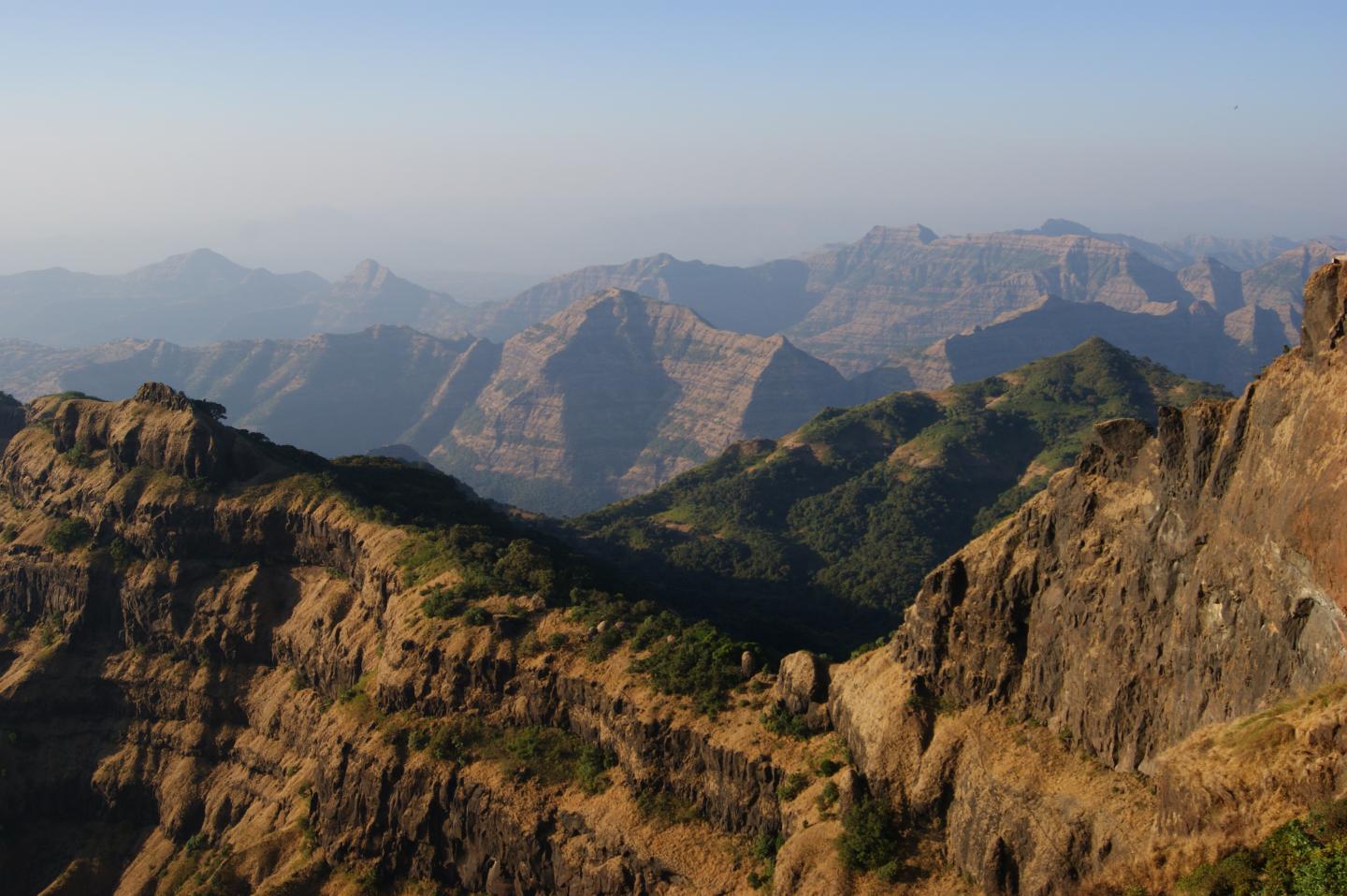
Everyone knows an asteroid strike wiped out the dinosaurs, right? Lots of evidence shows that the Chicxulub impact event had terrible consequences for the dinosaurs. But the picture is a little more complicated than that. Extreme volcanic activity may have contributed to the extinction.
Continue reading “Massive Volcanic Eruptions 66 Million Years Ago Happened Almost Exactly When the Dinosaurs Died Off”A Rapid Rise in Temperature Led to the Worst Extinction in our Planet’s History
![This illustration shows the percentage of marine animals that went extinct during Earth's worst extinction at the end of the Permian era by latitude, from the model (black line) and from the fossil record (blue dots).A greater percentage of marine animals survived in the tropics than at the poles. The color of the water shows the temperature change, with red being most severe warming and yellow less warming. At the top is the supercontinent Pangaea, with massive volcanic eruptions emitting carbon dioxide. The images below the line represent some of the 96 percent of marine species that died during the event. [Includes fossil drawings by Ernst Haeckel/Wikimedia; Blue crab photo by Wendy Kaveney/Flickr; Atlantic cod photo by Hans-Petter Fjeld/Wikimedia; Chambered nautilus photo by John White/CalPhotos.]Justin Penn and Curtis Deutsch/University of Washington](https://www.universetoday.com/wp-content/uploads/2018/12/Penn_sumfig_final.jpg)
Everyone knows about the extinction of the dinosaurs. A cataclysmic asteroid strike about 66 million years ago (mya) caused the Death of the Dinosaurs. But there’ve been several mass extinctions in the Earth’s history, and they didn’t involve killer asteroids. The worst extinction was caused by a rapid rise in temperature.
Earth’s most severe extinction occurred long before the killer asteroid impact that wiped out the dinosaurs. It happened some 252 mya, and it marked the end of what’s called the Permian Period. The extinction is known as the Permian-Triassic Extinction Event, the End-Permian Extinction, or more simply, “The Great Dying.” Up to 70% of terrestrial vertebrates and up to 96% of all marine species were extinguished during The Great Dying.
How did it happen? Could it happen again?
Continue reading “A Rapid Rise in Temperature Led to the Worst Extinction in our Planet’s History”
Io Afire With Volcanoes Under Juno’s Gaze

Volcanic activity on Io was discovered by Voyager 1 imaging scientist Linda Morabito. She spotted a little bump on Io’s limb while analyzing a Voyager image and thought at first it was an undiscovered moon. Moments later she realized that wasn’t possible — it would have been seen by earthbound telescopes long ago. Morabito and the Voyager team soon came to realize they were seeing a volcanic plume rising 190 miles (300 km) off the surface of Io. It was the first time in history that an active volcano had been detected beyond the Earth. For a wonderful account of the discovery, click here.

Today, we know that Io boasts more than 130 active volcanoes with an estimated 400 total, making it the most volcanically active place in the Solar System. Juno used its Jovian Infrared Aurora Mapper (JIRAM) to take spectacular photographs of Io during Perijove 7 last July, when we were all totally absorbed by close up images of Jupiter’s Great Red Spot.
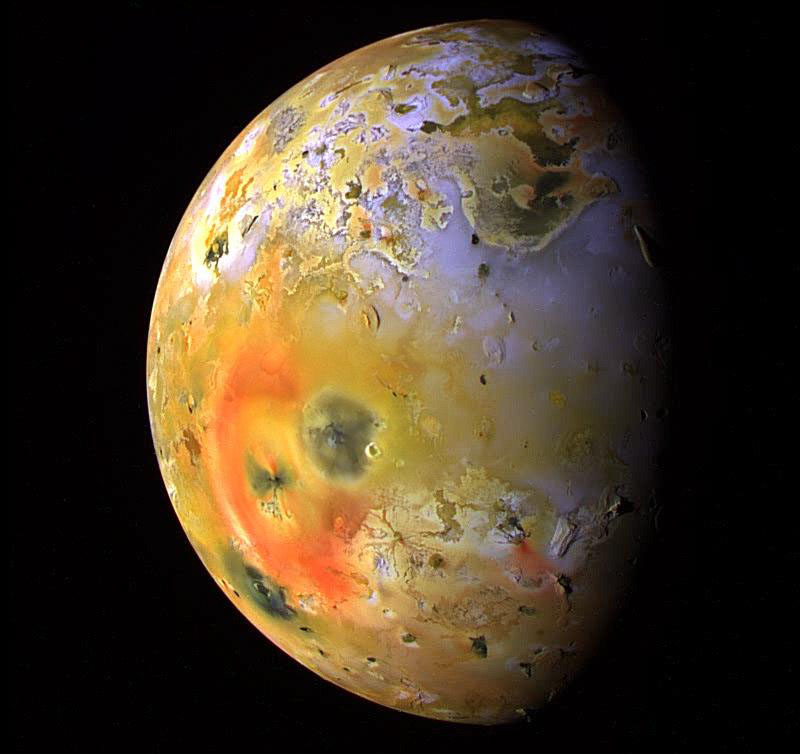
Juno’s Io looks like it’s on fire. Because JIRAM sees in infrared, a form of light we sense as heat, it picked up the signatures of at least 60 hot spots on the little moon on both the sunlight side (right) and the shadowed half. Like all missions to the planets, Juno’s cameras take pictures in black and white through a variety of color filters. The filtered views are later combined later by computers on the ground to create color pictures. Our featured image of Io was created by amateur astronomer and image processor Roman Tkachenko, who stacked raw images from this data set to create the vibrant view.
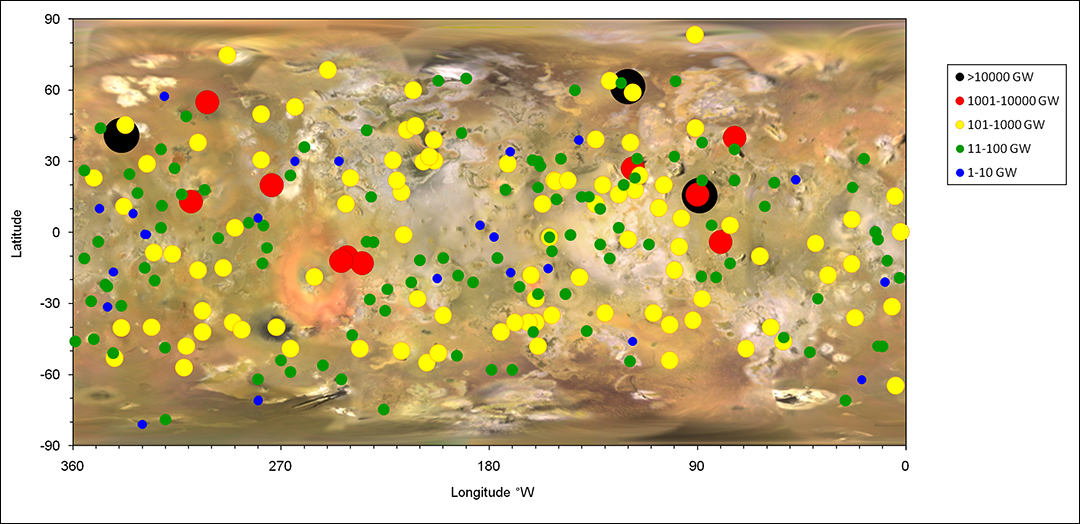
Io’s hotter than heck with erupting volcano temperatures as high as 2,400° F (1,300° C). Most of its lavas are made of basalt, a common type of volcanic rock found on Earth, but some flows consist of sulfur and sulfur dioxide, which paints the scabby landscape in unique colors.
This five-frame sequence taken by NASA’s New Horizons spacecraft on March 1, 2007 captures the giant plume from Io’s Tvashtar volcano.
Located more than 400 million miles from the Sun, how does a little orb only a hundred miles larger than our Moon get so hot? Europa and Ganymede are partly to blame. They tug on Io, causing it to revolve around Jupiter in an eccentric orbit that alternates between close and far. Jupiter’s powerful gravity tugs harder on the moon when its closest and less so when it’s farther away. The “tug and release”creates friction inside the satellite, heating and melting its interior. Io releases the pent up heat in the form of volcanoes, hot spots and massive lava flows.
Always expect big surprises from small things.
Astronauts Capture Great Views of Mount Etna Eruption
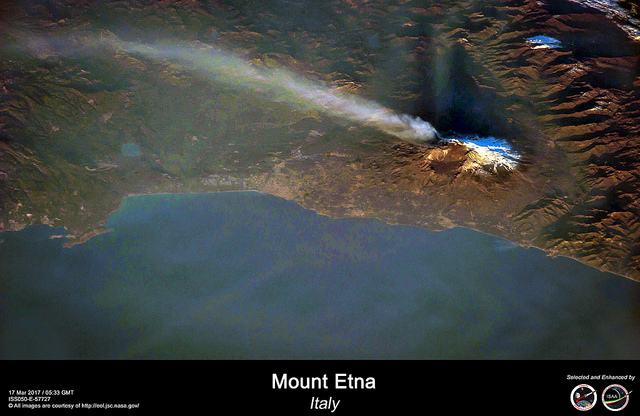
Mount Etna is Europe’s most active volcano, and it’s been spouting off since late February 2017. It spewed lava and gas with a rather big eruption last week, where 10 people were actually injured. The Expedition 50 crew on board the International Space Station have been able to capture both day and nighttime views of the activity from orbit.
The stunning view, above, was taken on March 17, 2017. The original photo, which you can see on NASA’s Gateway to Astronaut Photography of Earth website is actually a bit hard to make out. But space enthusiast Riccardo Rossi from Modena, Italy enhanced the original with color correction and increased the contrast with Photoshop. You can see the full version of Rossi’s enhancements on Flickr. .
ESA astronaut Thomas Pesquet took the image below on March 19, and shared it on Twitter, writing, “Mount Etna, in Sicily. The volcano is currently erupting and the molten lava is visible from space, at night! (the red lines on the left).”
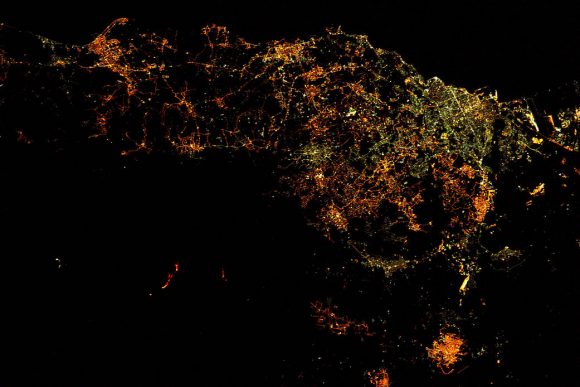
This crop shows the glowing lava:
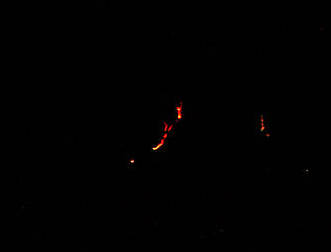
Mount Etna towers above the city of Catania on the island of Sicily. Scientists estimate it has been active for about 500,000 years. The first recorded eruption dates back to 1500 B.C., and it has erupted over 200 times since then.
NASA’s Suomi NPP satellite also spotted nighttime activity from orbit. The image was acquired by the Visible Infrared Imaging Radiometer Suite (VIIRS), using its “day-night band,” which detects light in a range of wavelengths and uses filtering techniques to observe signals such as gas flares, city lights, and reflected moonlight. In this image, it detected the nighttime glow of molten lava.
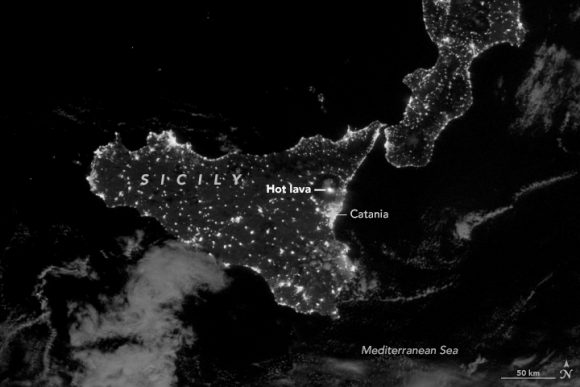
Further reading:
NASA Image of the Day
NASA Earth Observatory
Meteorite Confirms 2 Billion Years of Volcanic Activity on Mars
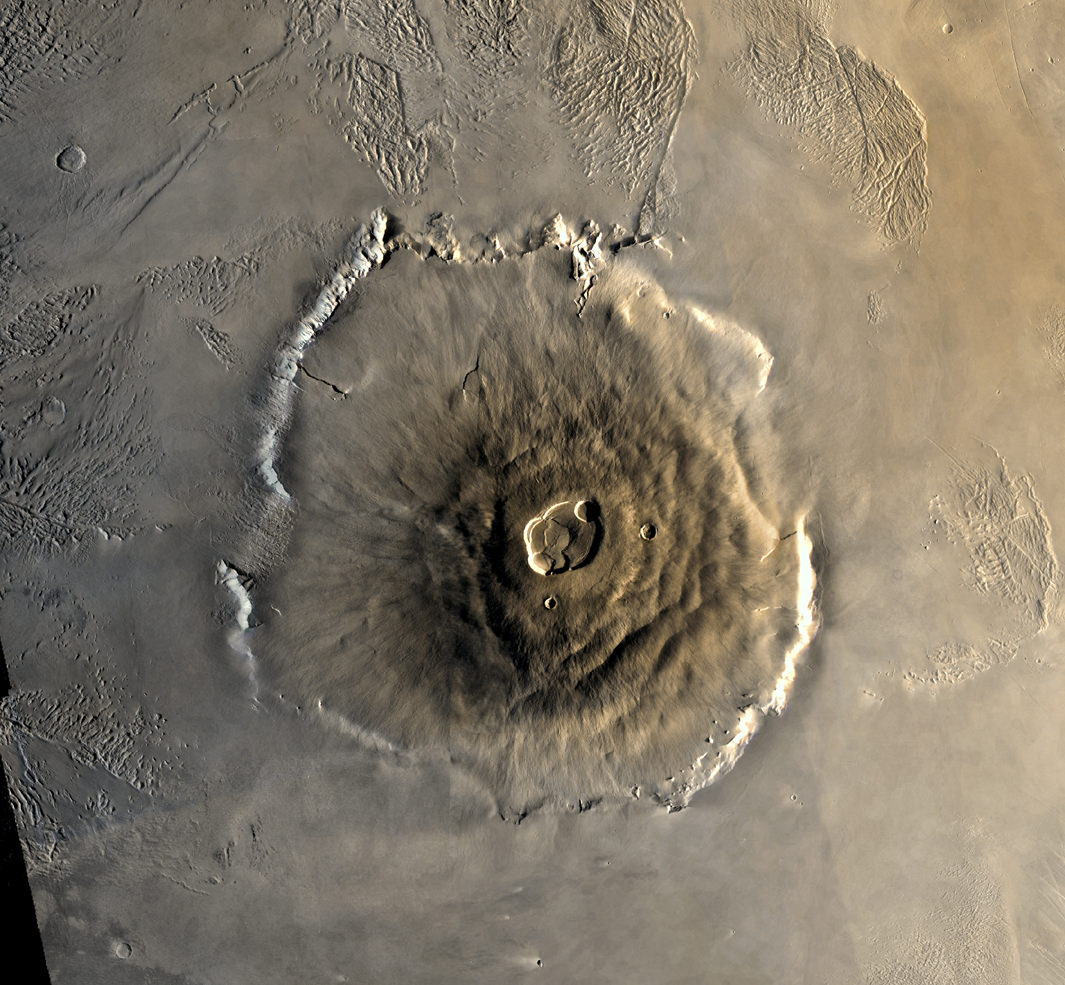
Mars is renowned for having the largest volcano in our Solar System, Olympus Mons. New research shows that Mars also has the most long-lived volcanoes. The study of a Martian meteorite confirms that volcanoes on Mars were active for 2 billion years or longer.
A lot of what we know about the volcanoes on Mars we’ve learned from Martian meteorites that have made it to Earth. The meteorite in this study was found in Algeria in 2012. Dubbed Northwest Africa 7635 (NWA 7635), this meteorite was actually seen travelling through Earth’s atmosphere in July 2011.
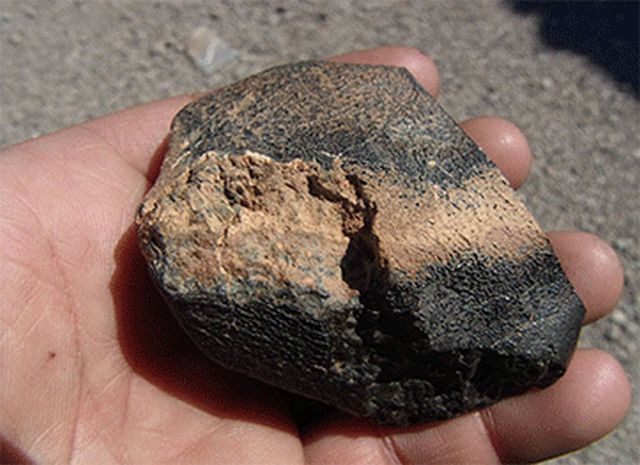
The lead author of this study is Tom Lapen, a Geology Professor at the University of Houston. He says that his findings provide new insights into the evolution of the Red Planet and the history of volcanic activity there. NWA 7635 was compared with 11 other Martian meteorites, of a type called shergottites. Analysis of their chemical composition reveals the length of time they spent in space, how long they’ve been on Earth, their age, and their volcanic source. All 12 of them are from the same volcanic source.
Mars has much weaker gravity than Earth, so when something large enough slams into the Martian surface, pieces of rock are ejected into space. Some of these rocks eventually cross Earth’s path and are captured by gravity. Most burn up, but some make it to the surface of our planet. In the case of NWA 7635 and the other meteorites, they were ejected from Mars about 1 million years ago.
“We see that they came from a similar volcanic source,” Lapen said. “Given that they also have the same ejection time, we can conclude that these come from the same location on Mars.”
Taken together, the meteorites give us a snapshot of one location of the Martian surface. The other meteorites range from 327 million to 600 million years old. But NWA 7635 was formed 2.4 billion years ago. This means that its source was one of the longest lived volcanoes in our entire Solar System.

Volcanic activity on Mars is an important part of understanding the planet, and whether it ever harbored life. It’s possible that so-called super-volcanoes contributed to extinctions here on Earth. The same thing may have happened on Mars. Given the massive size of Olympus Mons, it could very well have been the Martian equivalent of a super-volcano.
The ESA’s Mars Express Orbiter sent back images of Olympus Mons that showed possible lava flows as recently as 2 million years ago. There are also lava flows on Mars that have a very small number of impact craters on them, indicating that they were formed recently. If that is the case, then it’s possible that Martian volcanoes will be visibly active again.
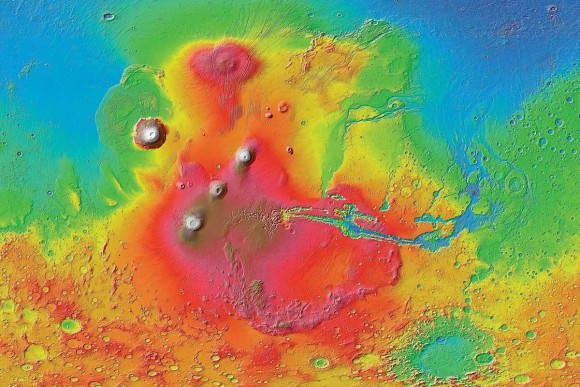
Continuing volcanic activity on Mars is highly speculative, with different researchers arguing for and against it. The relatively crater-free, smooth surfaces of some lava features on Mars could be explained by erosion, or even glaciation. In any case, if there is another eruption on Mars, we would have to be extremely lucky for one of our orbiters to see it.
But you never know.
Astronomy Cast Ep. 433: Volcanoes on Mars
So if you’ve been to Yellowstone National Park, you’ve seen one of the most amazing features of the natural world – geysers. In today’s episode, we’re going to talk about geysers on Earth, and where they might be in the solar system.
Visit the Astronomy Cast Page to subscribe to the audio podcast!
We usually record Astronomy Cast as a live Google+ Hangout on Air every Friday at 1:30 pm Pacific / 4:30 pm Eastern. You can watch here on Universe Today or from the Astronomy Cast Google+ page.
What are Volcanoes?
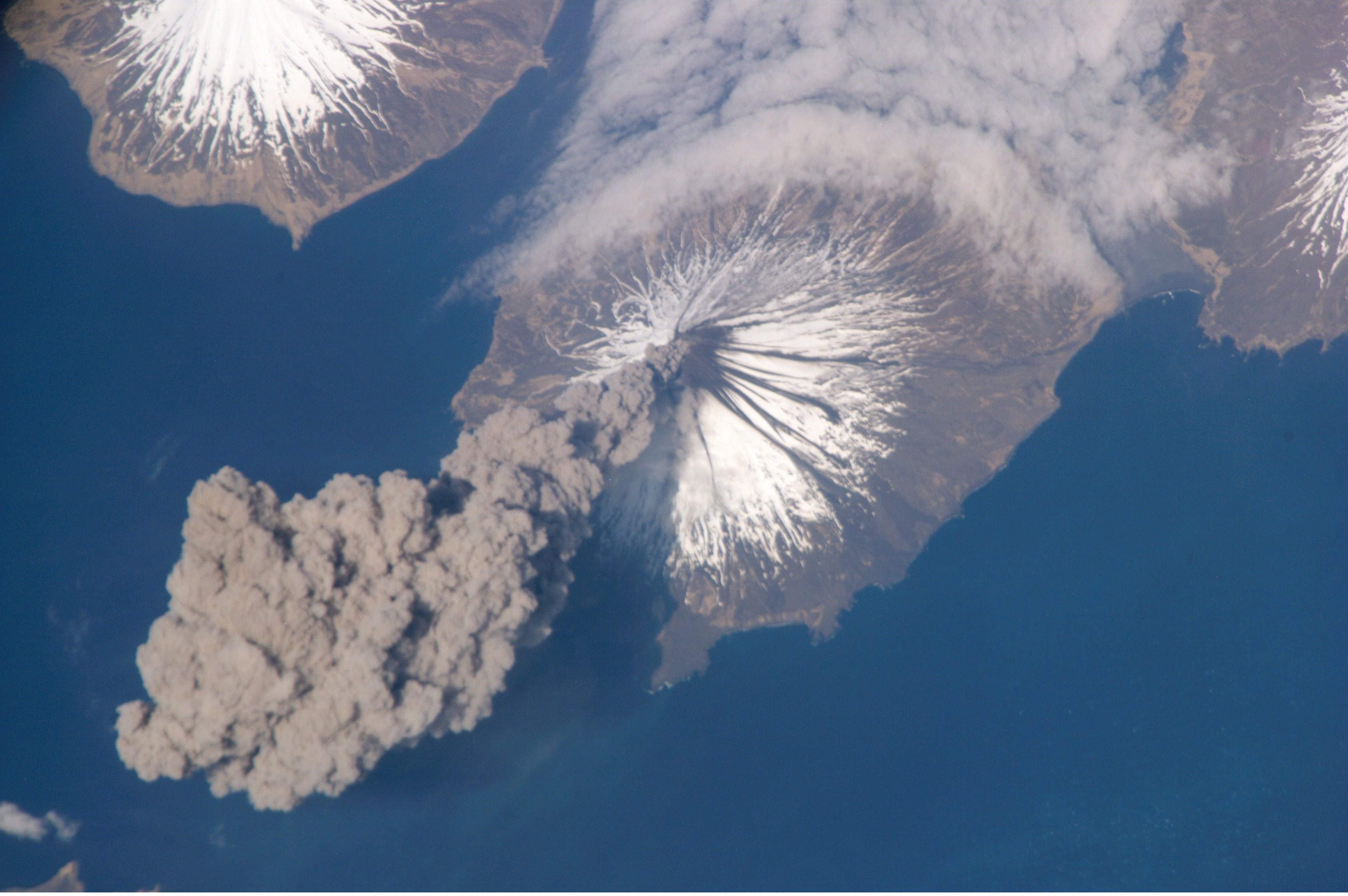
A volcano is an impressive sight. When they are dormant, they loom large over everything on the landscape. When they are active, they are a destructive force of nature that is without equal, raining fire and ash down on everything in site. And during the long periods when they are not erupting, they can also be rather beneficial to the surrounding environment.
But just what causes volcanoes? When it comes to our planet, they are the result of active geological forces that have shaped the surface of the Earth over the course of billions of years. And interestingly enough, there are plenty of examples of volcanoes on other bodies within our Solar System as well, some of which put those on Earth to shame!
Definition:
By definition, a volcano is a rupture in the Earth’s (or another celestial body’s) crust that allows hot lava, volcanic ash, and gases to escape from a magma chamber located beneath the surface. The term is derived from Vulcano, a volcanically-active island located of the coast of Italy who’s name in turn comes from the Roman god of fire (Vulcan).

On Earth, volcanoes are the result of the action between the major tectonic plates. These sections of the Earth’s crust are rigid, but sit atop the relatively viscous upper mantle. The hot molten rock, known as magma, is forced up to the surface – where it becomes lava. In short, volcanoes are found where tectonic plates are diverging or converging – such as the Mid-Atlantic Ridge or the Pacific Ring of Fire – which causes magma to be forced to the surface.
Volcanoes can also form where there is stretching and thinning of the crust’s interior plates, such as in the the East African Rift and the Rio Grande Rift in North America. Volcanism can also occur away from plate boundaries, where upwelling magma is forced up into brittle sections of the crust, forming volcanic islands – such as the Hawaiian islands.
Erupting volcanoes pose many hazards, and not just to the surrounding countryside. In their immediate vicinity, hot, flowing lava can cause extensive damage to the environment, property, and endanger lives. However, volcanic ash can cause far-reaching damage, raining sulfuric acid, disrupting air travel, and even causing “volcanic winters” by obscuring the Sun (thus triggering local crop failures and famines).
Types of Volcanoes:
There are four major types of volcanoes – cinder cone, composite and shield volcanoes, and lava domes. Cinder cones are the simplest kind of volcano, which occur when magma is ejected from a volcanic vent. The ejected lava rains down around the fissure, forming an oval-shaped cone with a bowl-shaped crater on top. They are typically small, with few ever growing larger than about 300 meters (1,000 feet) above their surroundings.
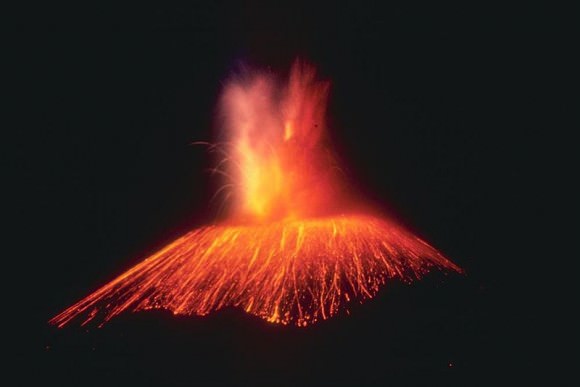
Composite volcanoes (aka. stratovolcanoes) are formed when a volcano conduit connects a subsurface magma reservoir to the Earth’s surface. These volcanoes typically have several vents that cause magma to break through the walls and spew from fissures on the sides of the mountain as well as the summit.
These volcanoes are known for causing violent eruptions. And thanks to all this ejected material, these volcanoes can grow up to thousands of meters tall. Examples include Mount Rainier (4,392 m; 14,411 ft), Mount Fuji (3,776 m; 12,389 ft), Mount Cotopaxi (5,897 m; 19,347 ft) and Mount Saint Helens (2,549 mm; 8,363 ft).
Shield volcanoes are so-named because of their large, broad surfaces. With these types of volcanoes, the lava that pours forth is thin, allowing it to travel great distances down the shallow slopes. This lava cools and builds up slowly over time, with hundreds of eruptions creating many layers. They are therefore not likely to be catastrophic. Some of the best known examples are those that make up the Hawaiian Islands, especially Mauna Loa and Mauna Kea.
Volcanic or lava domes are created by small masses of lava which are too viscous to flow very far. Unlike shield volcanoes, which have low-viscosity lava, the slow-moving lava simply piles up over the vent. The dome grows by expansion over time, and the mountain forms from material spilling off the sides of the growing dome. Lava domes can explode violently, releasing a huge amount of hot rock and ash.
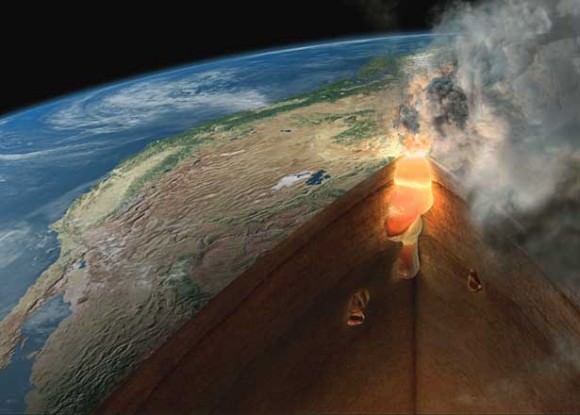
Volcanoes can also be found on the ocean floor, known as submarine volcanoes. These are often revealed through the presence of blasting steam and rocky debris above the ocean’s surface, though the pressure of the ocean’s water can often prevent an explosive release.
In these cases, lava cools quickly on contact with ocean water, and forms pillow-shaped masses on the ocean floor (called pillow lava). Hydrothermal vents are also common around submarine volcano, which can support active and peculiar ecosystems because of the energy, gases and minerals they release. Over time, the formations created by submarine volcanoes may become so large that they become islands.
Volcanoes can also developed under icecaps, which are known as subglacial volcanoes. In these cases, flat lava flows on top of pillow lava, which results from lava quickly cooling upon contact with ice. When the icecap melts, the lava on top collapses, leaving a flat-topped mountain. Very good examples of this type of volcano can be seen in Iceland and British Columbia, Canada.
Examples on Other Planets:
Volcanoes can be found on many bodies within the Solar System. Examples include Jupiter’s moon Io, which periodically experiences volcanic eruptions that reach up to 500 km (300 mi) into space. This volcanic activity is caused by friction or tidal dissipation produced in Io’s interior, which is responsible for melting a significant amount of Io’s mantle and core.
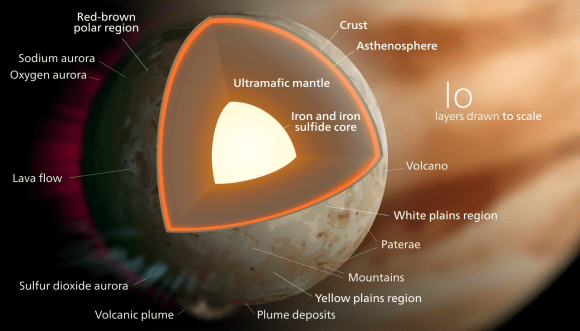
It’s colorful surface (orange, yellow, green, white/grey, etc.) shows the presence of sulfuric and silicate compounds, which were clearly deposited by volcanic eruptions. The lack of impact craters on its surface, which is uncommon on a Jovian moon, is also indicative of surface renewal.
Mars has also experienced intense volcanic activity in its past, as evidenced by Olympus Mons – the largest volcano in the Solar System. While most of its volcanic mountains are extinct and collapsed, the Mars Express spacecraft observed evidence of more recent volcanic activity, suggesting that Mars may still be geologically active.
Much of Venus’ surface has been shaped by volcanic activity as well. While Venus has several times the number of Earth’s volcanoes, they were believed to all be extinct. However, there is a multitude of evidence that suggests that there may still be active volcanoes on Venus which contribute to its dense atmosphere and runaway Greenhouse Effect.
For instance, during the 1970s, multiple Soviet Venera missions conducted surveys of Venus. These missions obtained evidence of thunder and lightning within the atmosphere, which may have been the result of volcanic ash interacting with the atmosphere. Similar evidence was gathered by the ESA’s Venus Express probe in 2007.

This same mission observed transient localized infrared hot spots on the surface of Venus in 2008 and 2009, specifically in the rift zone Ganis Chasma – near the shield volcano Maat Mons. The Magellan probe also noted evidence of volcanic activity from this mountain during its mission in the early 1990s, using radar-sounding to detect ash flows near the summit.
Cryovolcanism:
In addition to “hot volcanoes” that spew molten rock, there are also cryovolcanoes (aka. “cold volcanoes”). These types of volcanoes involve volatile compounds – i.e. water, methane and ammonia – instead of lava breaking through the surface. They have been observed on icy bodies in the Solar System where liquid erupts from ocean’s hidden in the moon’s interior.
For instance, Jupiter’s moon Europa, which is known to have an interior ocean, is believed to experiences cryovolcanism. The earliest evidence for this had to do with its smooth and young surface, which points towards endogenic resurfacing and renewal. Much like hot magma, water and volatiles erupt onto the surface where they then freeze to cover up impact craters and other features.
In addition, plumes of water were observed in 2012 and again in 2016 using the Hubble Space Telescope. These intermittent plumes were observed on both occasions to be coming in the southern region of Europa, and were estimated to be reach up to 200 km (125 miles) before depositing water ice and material back onto the surface.
In 2005, the Cassini-Huygens mission detected evidence of cryovolcanism on Saturn’s moons Titan and Enceladus. In the former case, the probe used infrared imaging to penetrate Titan’s dense clouds and detect signs of a 30 km (18.64 mi) formation, which was believed to be caused by the upwelling of hydrocarbon ices beneath the surface.
On Enceladus, cryovolcanic activity has been confirmed by observing plumes of water and organic molecules being ejected from the moon’s south pole. These plumes are are thought to have originated from the moon’s interior ocean, and are composed mostly of water vapor, molecular nitrogen, and volatiles (such as methane, carbon dioxide and other hydrocarbons).
In 1989, the Voyager 2 spacecraft observed cryovolcanoes ejecting plumes of water ammonia and nitrogen gas on Neptune’s moon Triton. These nitrogen geysers were observed sending plumes of liquid nitrogen 8 km (5 mi) above the surface of the moon. The surface is also quite young, which was seen as indication of endogenic resurfacing. It is also theorized that cryovolcanism may also be present on the Kuiper Belt Object Quaoar.
Here on Earth, volcanism takes the form of hot magma being pushed up through the Earth’s silicate crust due to convention in the interior. However, this kind of activity is present on all planet that formed from silicate material and minerals, and where geological activity or tidal stresses are known to exist. But on other bodies, it consists of cold water and materials from the interior ocean being forced through to the icy surface.
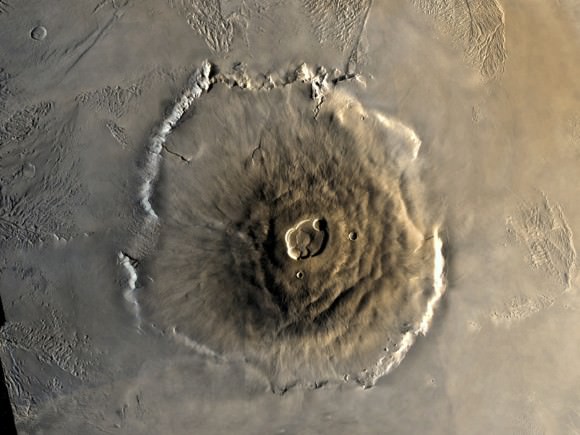
Today, our knowledge of volcanism (and the different forms it can take) is the result of improvements in both the field of geology, as well as space exploration. The more we learn of about other planets, the more we are able to see startling similarities and contrasts with our own (and vice versa).
We have written many interesting articles about volcanoes here at Universe Today. Here’s 10 Interesting Facts About Volcanoes, What are the Different Types of Volcanoes?, How Do Volcanoes Erupt?, What Are The Benefits Of Volcanoes?, What is the Difference Between Active and Dormant Volcanoes?
For more information, be sure to check out What is a Volcano? at NASA Space Place.
Astronomy Cast has an episode on the subject – Episode 141: Volcanoes Hot and Cold.
Sources:
What is the Difference Between Active and Dormant Volcanoes?
Volcanoes are an impressive force of nature. Physically, they dominate the landscape, and have an active role in shaping our planet’s geography. When they are actively erupting, they are an extremely dangerous and destructive force. But when they are passive, the soil they enrich can become very fertile, leading to settlements and cities being built nearby.
Such is the nature of volcanoes, and is the reason why we distinguish between those that are “active” and those that are “dormant”. But what exactly is the differences between the two, and how do geologists tell? This is actually a complicated question, because there’s no way to know for sure if a volcano is all done erupting, or if it’s going to become active again.
Put simply, the most popular way for classifying volcanoes comes down to the frequency of their eruption. Those that erupt regularly are called active, while those that have erupted in historical times but are now quiet are called dormant (or inactive). But in the end, knowing the difference all comes down to timing!

Active Volcano:
Currently, there is no consensus among volcanologists about what constitutes “active”. Volcanoes – like all geological features – can have very long lifespans, varying between months to even millions of years. In the past few thousand years, many of Earth’s volcanoes have erupted many times over, but currently show no signs of impending eruption.
As such, the term “active” can mean only active in terms of human lifespans, which are entirely different from the lifespans of volcanoes. Hence why scientists often consider a volcano to be active only if it is showing signs of unrest (i.e. unusual earthquake activity or significant new gas emissions) that mean it is about to erupt.
The Smithsonian Global Volcanism Program defines a volcano as active only if it has erupted in the last 10,000 years. Another means for determining if a volcano is active comes from the International Association of Volcanology, who use historical time as a reference (i.e. recorded history).

By this definition, those volcanoes that have erupted in the course of human history (which includes more than 500 volcanoes) are defined as active. However, this too is problematic, since this varies from region to region – with some areas cataloging volcanoes for thousands of years, while others only have records for the past few centuries.
As such, an “active volcano” can be best described as one that’s currently in a state of regular eruptions. Maybe it’s going off right now, or had an event in the last few decades, or geologists expect it to erupt again very soon. In short, if its spewing fire or likely to again in the near future, then it’s active!
Dormant Volcano:
Meanwhile, a dormant volcano is used to refer to those that are capable of erupting, and will probably erupt again in the future, but hasn’t had an eruption for a very long time. Here too, definitions become complicated since it is difficult to distinguish between a volcano that is simply not active at present, and one that will remain inactive.
Volcanoes are often considered to be extinct if there are no written records of its activity. Nevertheless, volcanoes may remain dormant for a long period of time. For instance, the volcanoes of Yellowstone, Toba, and Vesuvius were all thought to be extinct before their historic and devastating eruptions.

The same is true of the Fourpeaked Mountain eruption in Alaska in 2006. Prior to this, the volcano was thought to be extinct since it had not erupted for over 10,000 years. Compare that to Mount Grímsvötn in south-east Iceland, which erupted three times in the past 12 years (in 2011, 2008 and 2004, respectively).
And so a dormant volcano is actually part of the active volcano classification, it’s just that it’s not currently erupting.
Extinct Volcano:
Geologists also employ the category of extinct volcano to refer to volcanoes that have become cut off from their magma supply. There are many examples of extinct volcanoes around the world, many of which are found in the Hawaiian-Emperor Seamount Chain in the Pacific Ocean, or stand individually in some areas.
For example, the Shiprock volcano, which stands in Navajo Nation territory in New Mexico, is an example of a solitary extinct volcano. Edinburgh Castle, located just outside the capitol of Edinburgh, Scotland, is famously located atop an extinct volcano.

But of course, determining if a volcano is truly extinct is often difficult, since some volcanoes can have eruptive lifespans that measure into the millions of years. As such, some volcanologists refer to extinct volcanoes as inactive, and some volcanoes once thought to be extinct are now referred to as dormant.
In short, knowing if a volcano is active, dormant, or extinct is complicated and all comes down to timing. And when it comes to geological features, timing is quite difficult for us mere mortals. Individuals and generations have limited life spans, nations rise and fall, and even entire civilization sometimes bite the dust.
But volcanic formations? They can endure for millions of years! Knowing if there still life in them requires hard work, good record-keeping, and (above all) immense patience.
We have written many articles about volcanoes for Universe Today. Here’s Ten Interesting Facts About Volcanoes, What are the Different Types of Volcanoes?, How Do Volcanoes Erupt?, What is a Volcano Conduit?, and What are the Benefits of Volcanoes?
Want more resources on the Earth? Here’s a link to NASA’s Human Spaceflight page, and here’s NASA’s Visible Earth.
We have also recorded an episode of Astronomy Cast about Earth, as part of our tour through the Solar System – Episode 51: Earth.
Sources:
Weekly Space Hangout – June 24, 2016: Dr. James Green
Host: Fraser Cain (@fcain)
Special Guest:
Dr. James Green is the NASA Director of Planetary Science.
Guests:
Morgan Rehnberg (MorganRehnberg.com / @MorganRehnberg)
Dave Dickinson (www.astroguyz.com / @astroguyz)
Kimberly Cartier ( KimberlyCartier.org / @AstroKimCartier )
Their stories this week:
Evidence for volcanic history on Mars
Impact of Brexit on UK science uncertain
FRIPON: A New All-Sky Meteor Network
Blue Origin conducts fourth launch, test
We’ve had an abundance of news stories for the past few months, and not enough time to get to them all. So we are now using a tool called Trello to submit and vote on stories we would like to see covered each week, and then Fraser will be selecting the stories from there. Here is the link to the Trello WSH page (http://bit.ly/WSHVote), which you can see without logging in. If you’d like to vote, just create a login and help us decide what to cover!
We record the Weekly Space Hangout every Friday at 12:00 pm Pacific / 3:00 pm Eastern. You can watch us live on Google+, Universe Today, or the Universe Today YouTube page.
You can also join in the discussion between episodes over at our Weekly Space Hangout Crew group in G+!

